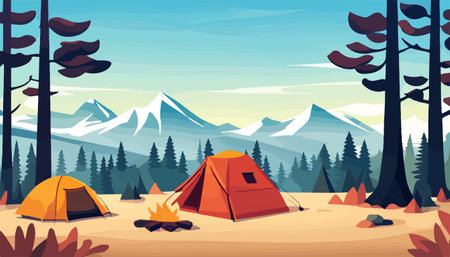1. Understanding Common Camping Emergencies
When heading out on a family campout with your pets, being prepared means knowing what kinds of emergencies you might face. Whether youre camping in a national park or at a local campground, its important to understand the common risks that can affect both your family and your furry companions.
Weather-Related Emergencies
Weather can change quickly outdoors. Thunderstorms, heavy rain, extreme heat, or unexpected cold snaps can catch families off guard. These conditions not only pose risks to people but can also be dangerous for pets. Dogs and cats can suffer from heatstroke or hypothermia just like humans. Make sure to check weather forecasts before you go and pack accordingly.
Weather Impact Comparison
| Weather Event | Impact on Humans | Impact on Pets |
|---|---|---|
| Thunderstorms | Risk of lightning, falling branches, flooding | Anxiety from thunder, risk of running away if off-leash |
| Extreme Heat | Heat exhaustion, dehydration | Paw burns from hot surfaces, heatstroke |
| Cold Weather | Hypothermia, frostbite | Short-haired breeds are especially vulnerable to cold stress |
Injuries and First Aid Needs
Cuts, scrapes, burns from campfires, or twisted ankles are common outdoor injuries. Pets may also get paw injuries from rocky terrain or sharp objects. Its important to bring a first aid kit that includes supplies for both people and animals. Learn basic pet first aid before you go—knowing how to treat a bleeding paw or remove a tick can make a big difference.
Wildlife Encounters
Depending on where youre camping, you may come across raccoons, snakes, bears, or even coyotes. Wildlife encounters can be scary—and dangerous—for pets and children alike. Always keep food stored properly and never leave pets unattended outside the tent or camper. Even smaller animals like skunks can cause problems if they spray your dog!
Common Wildlife Dangers
| Animal | Risk to Humans | Risk to Pets |
|---|---|---|
| Bears | Aggression if surprised near food sources | May attack dogs that bark or chase them |
| Snakes | Bites can be venomous; hard to spot in brush | Nose-first curiosity makes bites more likely in pets |
| Raccoons/Skunks | Disease carriers (rabies), nuisance around food areas | Can bite or spray curious pets; potential disease transmission |
The Unique Factor: Camping with Pets
Bringing pets adds another layer of responsibility during emergencies. They rely on you for safety and comfort in unfamiliar environments. Unlike adults who can follow directions or help in an emergency situation, pets need to be guided and protected throughout any crisis. Always plan with their needs in mind—from shelter options to emergency evacuation routes that allow animals.
Quick Tips for Pet-Inclusive Emergency Readiness:
- ID Tags & Microchips: Ensure all pets have up-to-date ID tags and are microchipped.
- Leashes & Crates: Keep them secured at all times—especially during unpredictable situations.
- Pet First Aid Kit: Include items like gauze pads, tweezers, antiseptic wipes, and vet-approved meds.
- No-Pet Zones: Know which trails or areas don’t allow animals so you can avoid last-minute issues.
- Shelter Planning: Bring extra blankets for warmth or shade structures for cooling off.
This understanding sets the foundation for building an emergency prep plan that works for every member of your camping crew—including the four-legged ones.
2. Creating a Pet-Inclusive Emergency Plan
When youre camping with your whole family — furry members included — having a solid emergency plan is essential. Emergencies can happen fast, whether its a sudden thunderstorm, wildfire, or unexpected wildlife encounter. Planning ahead ensures everyone knows what to do, and no one (including your pet) gets left behind.
Evacuation Procedures
Start by identifying possible emergencies specific to your camping location. Then, create clear evacuation routes and meeting points. Make sure these plans include how youll transport your pet safely and quickly. Practice these drills with your family so everyone feels confident if the real thing happens.
Pet Evacuation Kit Checklist
| Item | Purpose |
|---|---|
| Leash/Harness | Keep pet under control during evacuation |
| Collapsible Water Bowl & Bottled Water | Hydration on the go |
| Pet Food (3-day supply) | Maintain regular feeding schedule |
| Vaccination Records & ID Tags | Proof of health and identification if separated |
| Pet Carrier or Crate | Safe transport and temporary shelter |
Assigning Family Roles
A successful emergency response depends on teamwork. Assign specific tasks to each family member to avoid confusion and save time during an actual emergency.
Example Role Assignment Chart:
| Family Member | Responsibility |
|---|---|
| Parent 1 | Lead evacuation route; carry emergency kit |
| Parent 2 | Secure pets; grab pet supplies and documents |
| Older Child | Assist younger siblings; help pack essentials |
| Younger Child (if age-appropriate) | Stay close to assigned adult; carry small flashlight or whistle |
Emergency Contacts & Communication Plan
Create a list of emergency contacts including park rangers, local animal shelters, and nearby veterinary clinics. Keep this list in both digital and printed form inside your emergency kit. Decide on a communication strategy — such as text messages or walkie-talkies — in case cell service is limited.
Important Contact List Template:
| Contact Type | Name/Location | Phone Number | |||||||||||||||||||||||||||||||||||||||||||||||
|---|---|---|---|---|---|---|---|---|---|---|---|---|---|---|---|---|---|---|---|---|---|---|---|---|---|---|---|---|---|---|---|---|---|---|---|---|---|---|---|---|---|---|---|---|---|---|---|---|---|
| Campground Office/Ranger Station | [Insert Name] | [Insert Phone] | |||||||||||||||||||||||||||||||||||||||||||||||
| Nearest Vet Clinic |
| Category | Items for Humans | Items for Pets |
|---|---|---|
| First Aid | Bandages, antiseptic wipes, tweezers, pain relievers, allergy meds | Paw bandages, pet-safe antiseptic, flea/tick treatment |
| Food & Water | Non-perishable snacks, bottled water, portable water filter | Dry or canned pet food, collapsible bowls, bottled water |
| Medications | Prescription medications with copies of prescriptions | Pet meds with dosage instructions from your vet |
| Documents | ID cards, health insurance info, emergency contacts list | Vaccination records, microchip number, recent photo of your pet |
| Comfort Items | Blanket, flashlight, whistle, hygiene supplies | Toy or blanket with familiar scent, leash/harness, poop bags |
Packing Tips
- Use waterproof containers: Store everything in clearly labeled plastic bins or dry bags to protect against moisture.
- Create grab-and-go kits: Keep smaller versions of your emergency kit in your daypack in case you venture away from camp.
- Check expiration dates: Rotate food and medication regularly to keep everything fresh and effective.
- Add seasonal items: Include insect repellent in summer or extra blankets during colder months.
Don’t Forget Pet-Specific Needs
Certain pets have unique needs depending on their age or breed. For example, older dogs might need joint supplements or special bedding. Make sure you consider these personal needs when assembling your kit.
Pro Tip:
If youre camping in areas prone to wildfires or storms, include a printed map of evacuation routes and nearby animal shelters that accept pets. Cell service may not always be reliable.
A thoughtful emergency kit makes a big difference when it comes to outdoor safety. With proper planning and the right supplies for both humans and pets, you’ll be ready to face any situation during your campout.
4. Staying Informed and Connected Off the Grid
When youre out camping with your family and pets, staying connected and informed is a key part of emergency preparedness. Even if youre off the grid, there are smart ways to stay updated on weather changes, wildfire alerts, or other local emergencies. Heres how you can keep everyone safe while enjoying the great outdoors.
Know the Local Emergency Channels
Before heading out, check which emergency services cover the area youll be camping in. This includes local sheriff departments, fire stations, and park ranger offices. Write down their contact information and save it both digitally and on paper.
Tip:
- Sign up for local alert systems like Nixle or county-specific emergency text alerts.
- Check for NOAA Weather Radio frequencies in the region.
Use Off-Grid Communication Tools
If cell service is unreliable where youre camping, consider using tools designed for off-grid communication. These tools help you send messages or share your location even when theres no signal.
| Tool | Description | Best For |
|---|---|---|
| Satellite Messengers (e.g., Garmin inReach) | Two-way messaging, SOS alerts, and GPS tracking via satellite | Remote locations with no cell service |
| Walkie Talkies/FRS Radios | Short-range voice communication between family members | Larger campsites or wooded areas |
| Emergency Beacons (PLBs) | Sends distress signals to emergency services with GPS location | Backcountry or solo travel safety |
Let Someone Know Your Plans
Always leave your itinerary with a trusted friend or relative. Include details like your campsite name, dates of stay, number of people and pets in your group, and expected return time. If possible, check in periodically by message or satellite device.
Checklist: Who Should Know Your Whereabouts?
- A close family member or friend at home
- The campground host or ranger station (if applicable)
- Your pet sitter or vet in case of animal-related emergencies
Create a Communication Plan with Your Group
If you’re camping with kids or multiple adults, make sure everyone knows what to do if someone gets separated. Designate a meeting point at camp and teach children how to use any devices you bring along.
Pro Tip:
Laminated cards with your name, campsite info, and emergency contact numbers can be clipped to backpacks or pet collars—just in case someone gets lost.
Staying informed while off the grid takes a little planning, but it’s one of the best ways to protect your loved ones—including your furry friends—during a camping adventure.
5. Training and Practicing Emergency Scenarios
When youre out camping with your family and pets, staying calm and acting fast during an emergency can make all the difference. The best way to be ready is by practicing what to do before anything happens. Just like fire drills at school or home, emergency drills at the campsite help everyone know their role—including your furry friends.
Why Practice Makes a Difference
In stressful situations, people and animals can panic. But when youve rehearsed a plan, youre more likely to stay focused and act quickly. Practicing emergency scenarios helps build confidence, reduce fear, and improve coordination among all family members—even kids and pets.
Types of Drills to Practice
You don’t need fancy gear or a lot of time to run through simple drills. Here are a few practice scenarios that can help:
| Scenario | What to Practice |
|---|---|
| Lost Pet | Call your pet using a specific whistle or command; practice attaching ID tags and using GPS trackers if available. |
| Fire in the Camp Area | Have everyone walk through how to safely evacuate with pets on leashes or in carriers. |
| Severe Weather (like lightning or windstorm) | Pretend to take shelter quickly; know where pet-friendly safe areas are located near your site. |
| Medical Emergency | Assign roles—who grabs the first aid kit, who stays with the injured person or pet, who calls for help. |
Involve Everyone—Including Pets
Pets may not understand whats going on, but they can learn from repetition. Practice putting them in their carrier or attaching their leash calmly. Use treats and praise so they associate drills with positive experiences.
Pro Tips:
- Keep your pet’s emergency bag ready—include food, water, meds, leash, and comfort items.
- Teach children how to help guide pets during emergencies without panicking.
- Create a simple checklist so nothing gets forgotten during practice runs.
Make It a Fun Family Activity
You can turn emergency training into a game or challenge for kids—like timing how fast everyone can pack up and move to safety. Reward participation with s’mores or extra campfire stories!
The Bottom Line
The more you practice together as a family (pets included), the more natural it becomes when facing real situations. Drills don’t need to be scary—they’re about making sure everyone knows what to do so you can enjoy your camping trip with peace of mind.
6. Post-Emergency Care and Recovery
After an emergency situation during your pet-friendly family campout, it’s important to take a step back and make sure everyone—humans and pets alike—is doing okay. Emergencies can be physically and emotionally draining, so taking time to recover is key to getting back to enjoying the outdoors safely.
Check for Physical Injuries
Start by checking every family member and pet for visible injuries. Even minor scrapes or cuts should be cleaned and treated properly to avoid infection. If anyone shows signs of more serious issues, such as broken bones, heavy bleeding, or trouble breathing, seek medical or veterinary care immediately.
Quick Injury Checklist
| Who | What to Check | Recommended Action |
|---|---|---|
| Adults & Kids | Cuts, bruises, dizziness, headaches | Clean wounds, apply bandages, hydrate, rest |
| Pets (dogs/cats) | Limping, bleeding paws, panting, vomiting | Inspect paws, offer water, keep calm, consult vet if needed |
Mental and Emotional Recovery
An emergency can leave lasting emotional stress. Talk with your kids about what happened using simple language. Let them express their feelings and reassure them that they’re safe now. Pets can also show signs of stress like shaking, hiding, or excessive barking or meowing.
Soothe Stress for Humans and Pets
- Create a calm environment: Set up a quiet area in your campsite where everyone can relax.
- Cuddle and comfort: Snuggle up with your kids and pets to give them a sense of security.
- Avoid overstimulation: Keep noise and activity levels low until everyone has calmed down.
Re-establish Camp Routine
A familiar routine helps both people and pets feel grounded again. Return to your regular meal times, bedtime rituals, walks with your dog, or playtime with your cat. This sense of normalcy can be incredibly comforting after a chaotic event.
Tips to Get Back on Track:
- Simplify activities: Don’t rush back into hiking or big adventures right away—start slow.
- Keeps things predictable: Feed pets at their usual times and use familiar bowls or blankets if possible.
- Praise positive behavior: Give treats or kind words when your pet behaves calmly after the incident.
The road back to a fun and relaxing campout may take some patience—but with careful attention to everyone’s wellbeing, you’ll help your family (furry members included) feel safe and ready for more outdoor fun.


